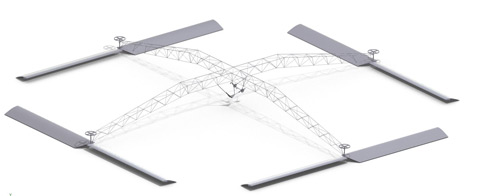
Students from the University of Maryland’s A. James Clark School of Engineering will test-fly a human-powered helicopter on May 11 in the hopes of winning a $250,000 prize from the American Helicopter Society (AHS) International.
Fifty graduate and undergraduate students have been working on the aircraft for two years. Called Gamera (after a giant flying turtle in Japanese monster movies), the aircraft has a rotor at each of the four ends of its X-shaped frame. The pilot, seated in a module suspended at the middle, powers the aircraft by a combination of hand and foot pedaling via chains, gears, and lightweight string to the rotors.
Gamera is constructed of balsa, foam, Mylar, carbon fiber, and other lightweight materials. With a pilot on board, it weighs just 210 pounds. If successful, the test flight also could capture a world record for human-powered helicopter flight with a female pilot.
The AHS’s Sikorsky Prize, named for Igor Sikorsky, will be awarded to a team that creates a vehicle that obtains all of its power from a human pilot and achieves a 60-second hover while remaining within a 10-meter square and momentarily reaching a three-meter altitude. In previous attempts, two vehicles have risen off the ground but failed to meet the competition criteria. No team has managed to win the prize since it was first announced in 1980, according to the University of Maryland.




